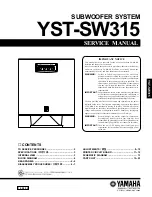
12
D E E P CO L L E CT I O N ™ I N STA L L AT I O N US E R M A N UA L
If possible, it’s often good to try to isolate the problem first. For example, if you’re playing
a DVD on a television and there’s no sound, try connecting an MP3 player to the system to
see if that works. If it does work, then the problem is with the television, DVD player, or the
cables connecting them. If it doesn’t work, the problem will be with the amplifier, speakers,
or those cables.
Troubleshooting
Problem
Possible Cause
No Sound
The volume may be turned down or muted. Check the volume settings
on both the amplifier and the television/computer/CD player/etc.
No Sound
Make sure the proper source is selected on the amplifier or receiver.
No Sound
Check the cord connecting the amplifier with the source. The cord may
be damaged or plugged into the wrong input or output.
No Sound
Check the wires connecting the amplifier with the speakers. Make sure
they’re connected properly and not damaged in any way.
Poor
Sound
Quality
If you hear something like static, or the sound is cutting in and out,
check the audio cables. If the problem increases when a cable is being
moved, then the cable is most likely faulty or not connected properly.
Poor
Sound
Quality
Today’s audio systems may have several places to adjust the volume,
for example your MP3 player may have a volume control, and your
amplifier may also have one. Check to be certain that the volume isn’t
turned up past 80% on any device.
Poor
Sound
Quality
Try changing sources to be certain that the selection you’ve chosen is
a good quality recording.




































